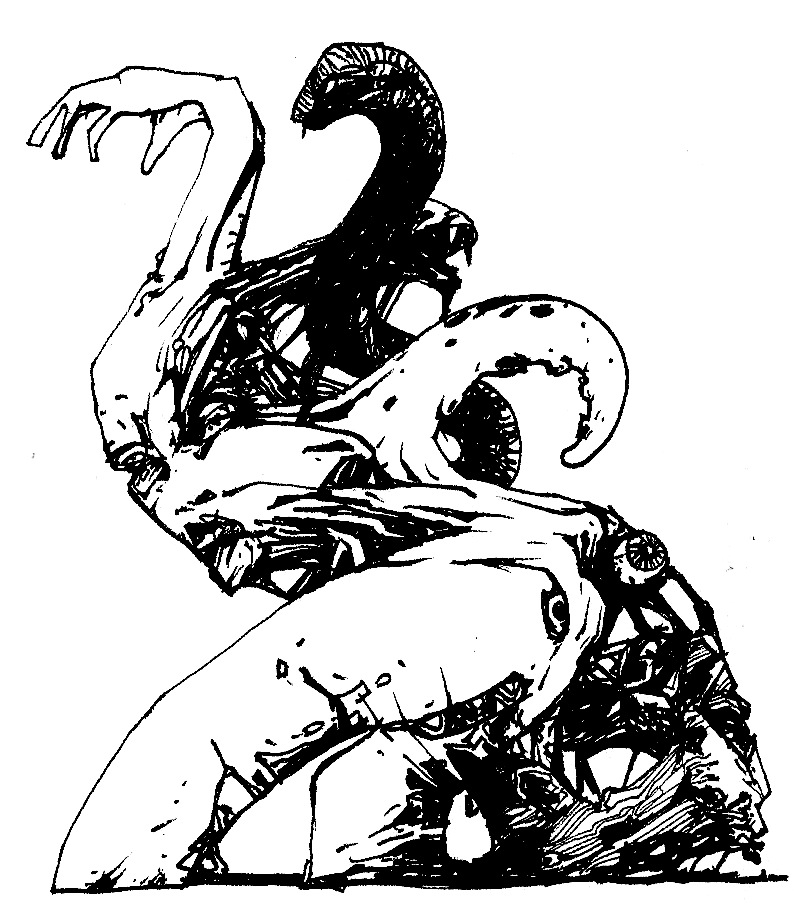

FREQUENCY: Very rare (at
best)
FREQUENCY: Very rare ([Dungeon Level III])
NO. APPEARING: 1
ARMOR CLASS: 5 (see below)
MOVE: 6" (see below)
HIT DICE: 5 (see below)
% IN LAIR: 10%
TREASURE TYPE: Nil
NO. OF ATTACKS: 2
DAMAGE/ATTACK: 1-4/1-4
SPECIAL ATTACKS: Nil
SPECIAL DEFENSES: See below
MAGIC RESISTANCE: Standard
INTELLIGENCE: Animal
ALIGNMENT: Neutral
SIZE: M <(about 4' high
&& 2' avg. diameter)>
LEVEL/X.P. VALUE: III |
130 + 5
The natural form of this
beast is a grey-green lumpy cylinder about 4'
high and 2' average diameter.
A short single leg trails behind the main
body and has a suction cup
like that of a snail. Other similar suction
cups under the main body
itself permit the beast a jerky mode of
locomotion. Two 5' long
tentacles emerge from the top of the body
but there are no apparent
eyes, ears or other features - indeed the
whole creature is a constantly
changing mass of a rubbery, dough-like
substance the same colour
as bilious human flesh.
The creature will not normally
attack unless threatened, but when it
does so it strikes with
its tentacles for 1-4 hit points of damage each.
When engaged in melee the
creature exhibits a startling power of
irnorphisrn. At the beginning
of each melee round (except the first) it
changes its hit dice and
armour class by 1 point each towards the
values of its opponent,
at the same time gradually changing its shape
to resemble its opponent's
shape. When hit dice and armour class (and
hence appearance) are the
same as those of its opponent, the creature
instantly alters its attack
and movement to fit the subject.
Note that the imorph assumes
only the physical appearance of i t s
opponent; though it will
grow various appendages to copy i t s
opponent's weapons and limbs,
it will still strike with the equivalent
of two tentacles each round
for 1-4 hit points of damage each (even
though one tentacle may
look like an arm wielding a sword and the
other an arm holding a shield,
for example). The hit points of the
imorph remain the same even
when the hit dice value changes.
However, the creature will
change its hit probability to conform to'its
new hit dice value.
When the imorph is exactly
the same shape as its opponent, has the
same hit dice and the same
armour class, it changes to the appropriate
attack matrix for its hit
probability (the fighter table, for example if
it is attacking a human
fighting man). It remaihs attacking on that
table until it starts to
change back again towards its original form.
When the melee is over,
or when the imorph is down to 8 hits or
fewer, it will revert to
its original form by the reverse process,
changing armour class and
hit dice by 1 point each per melee round.
If faced with more than
one attacker, the imorph will select one at
random to attack and to
emulate. If the original 'model' dies during
melee, or retreats, the
imorph will immediately start to alter in order
to emulate another opponent.
Within the creature's body
there is a small organ, corresponding to the
human liver, made of a rubbery
green substance. Within the organ is a
liquid of similar colour
which, when mixed with water in equal
quantity, serves as a potion
of polymorph self. There will be sufficient
liquid in a single imorph
to make 1-3 draughts of such a potion, and
it is for this reason that
the imorph is attacked by adventurers.
by Andrew Key